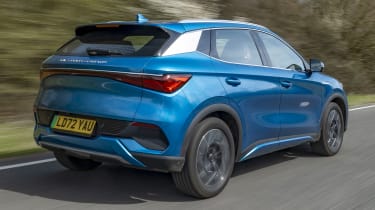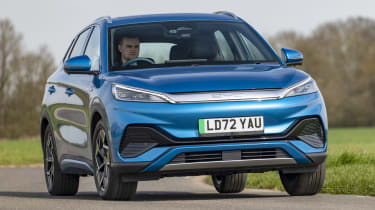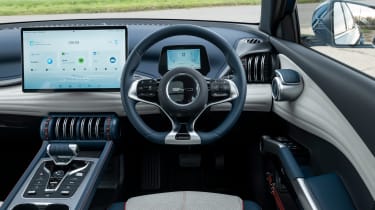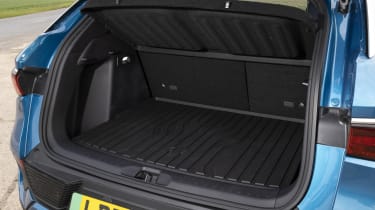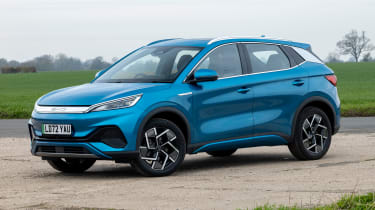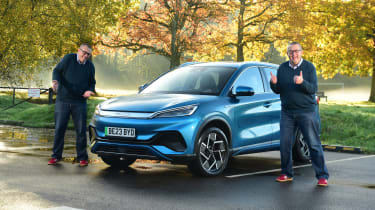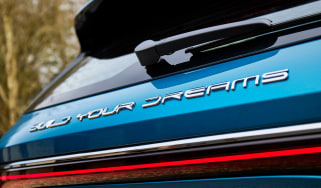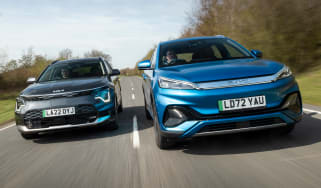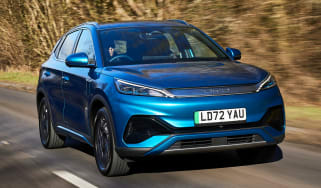BYD Atto 3 review
New kid on the block BYD has hit the ground running with its all-electric family SUV, combining quirky design with a comfortable ride in the Atto 3

If you don't care what badge your car wears, and can put up with a gimmick or two, there is a lot to like about the BYD Atto 3. It’s refined, comfortable and features a well built interior that’s bursting with technology and quirky elements, and offers a departure from the gloomy all-black cabins many other electric SUVs are sticking with.
The Atto 3 is perhaps not as polished in some areas as we’d like, and the ‘Build Your Dreams’ name stamped across the rear is probably not one of the features buyers will be quick to show off. But if you’re in the market for a family EV, the BYD ought to be on your radar.
Our choice: BYD Atto 3 Comfort
About the BYD Atto 3
You’d be forgiven for not knowing much, or indeed anything, about the BYD brand – or ‘Build Your Dreams’, to use its full name. Its parent company was founded in 1995 and BYD Auto established in 2003. Unlike other brands, BYD has always produced its own cars, although some have had very similar looks to existing models from other manufacturers.
Quick growth has seen BYD become one of China’s ‘big four’ car makers, and it was the country’s best-selling car brand in the first quarter of 2023. The Atto 3 is BYD’s first model available to order in the UK, but it’s already confirmed that the Dolphin family hatchback and Seal saloon – also fully electric cars – will be landing on British shores very soon.
More reviews
The Atto 3 uses BYD’s latest bespoke EV underpinnings, called e-Platform 3.0. This set-up can support front, rear and four-wheel drive, along with up to 800V electrics for ultra-rapid charging. In the case of the Atto 3, though, you get more conventional recharge speeds and a single motor driving the front wheels only. But the SUV does use BYD’s own ‘blade’ battery design, which is integrated into the car’s structure and claimed to save weight and space.
The 60.5kWh battery in all Atto 3s sold in the UK is good for a claimed range of 260 miles – just shy of its key rival, the Kia Niro EV, which we pitted head-to-head against the BYD. The less expensive but much more conventional MG ZS EV is another direct competitor, offering slightly more range and boot space, while the incoming all-new Hyundai Kona Electric will certainly give the Atto 3 a run for its money.
Speaking of which, with prices starting from close to £36,500 and rising to £39,000 for a top-of-the-range model, the Atto 3 must also contend with electric family SUVs like the Volkswagen ID.4 and Skoda Enyaq iV.
There are no options for buyers to choose from, just five paint colours and three trim levels called Active, Comfort and Design, with very few differences between them. Standard kit on all models includes LED headlights and a rear light bar, two-zone climate control, 18-inch alloy wheels, vehicle-to-grid charging, an eight-speaker stereo, an air-purification system, rhythm-reactive ambient lighting, a panoramic roof, keyless entry & starting, electric front seats with artificial leather upholstery, and a rotating central touchscreen with Apple CarPlay and Android Auto connectivity. It’s a 12.8-inch display in Active and Comfort models, and 15.6 inches in top-spec versions.
Motors, performance and drive
The Atto 3 is focused on comfort more than sharp handling, but that’s hardly a bad thing for an electric SUV aimed at families. At lower speeds, the raised ride height and soft suspension allow it cope admirably with rough urban roads. When we tested the Atto 3 against a Kia Niro EV, we found the BYD was more refined and less fidgety than the Kia around town.
Like a lot of EVs, the Atto 3 emits a noise at low speeds to alert other road users and pedestrians of your presence. However, it’s not pleasant, with a tone that sounds like an open telephone line. Thankfully the artificial sound generator falls silent once you get beyond 20mph.
The Atto 3 only offers two levels of brake regeneration, and while we preferred the stronger of the two, it fails to provide one-pedal driving like the Niro EV. Meanwhile, the steering doesn’t provide much feedback, and we found it was eager to self-centre at slow speeds.
Find yourself on a twisty country road, and you’ll notice a fair amount of body roll in corners, but that’s hardly surprising. However, the soft suspension that cushions you from bumps around town also causes the Atto 3 to pitch and dive if you’re hard on the accelerator or brakes. Keen drivers should look elsewhere, then. At higher speeds, cruising comfort is fine, except for a bit of wind noise around the door mirrors.
0-62mph acceleration and top speed
The Atto 3’s single electric motor produces 201bhp and 310Nm of torque – not an enormous amount by EV standards, but enough to propel the 1.7-tonne electric SUV from 0-62mph in 7.3 seconds and onto a top speed of 99mph. Power delivery off the line is relatively gentle, but once you’re up to your desired speed, the Atto 3 is happy cruising along.
Range, charging and running costs
The Atto 3’s battery uses BYD’s latest ‘blade’ technology – in effect, long strips of cells that run from front to rear along the car, with none of the modules that feature on other vehicles (including VW’s ID. offerings). This set-up is claimed to save weight and space, allowing BYD to deliver better range out of its lithium-iron-phosphate (LFP-technology) cells, which would otherwise be a bit less energy-dense than the NCM (nickel-cobalt-manganese) tech that you’ll find on many other cars.
In some markets the Atto 3 is offered with two battery sizes – 48kWh and 60.5kWh – however UK buyers only get the larger unit, which delivers a claimed range of up to 260 miles. That’s just shy of the Atto 3’s key rivals, the Kia Niro EV and MG ZS EV, which have a maximum range of 285 and 273 miles respectively. But the Atto 3’s standard-fit heat pump that helps with heating the cabin should help it retain more of its range in cold weather. Kia does offer a heat pump for the Niro EV, but it’s a £900 option.
When we pitted the BYD Atto 3 head-to-head against the Kia Niro EV, we saw a return of 3.5 miles per kWh from the BYD, compared to 3.7mi/kWh for the Kia. That equates to a real-world range of 212 miles – 18 per cent down on the Atto 3’s claimed range, and nearly 30 miles less than the Niro EV could cover on a single charge.
Speaking of charging, the Atto 3’s 88kW maximum charging speed isn’t exactly lightning fast, especially when you consider most electric cars are capable of reaching 100-150kW via the right DC rapid charger. Its capabilities are very similar to that of the Niro EV and MG ZS EV, but that just means – as with its rivals – a typical top-up from 10 to 80 per cent using a 100kW rapid charger will take 44 minutes.
When it comes to charging at home, it will take a typical 7kW home wallbox nearly 10 hours to fully replenish the Atto 3’s 60.5kWh battery. However BYD currently offers an 11kW home wallbox installation as part of the top-spec Atto 3’s price, which only needs six-and-a-half hours to fully recharge the Atto 3.
Insurance groups
Insurance groups for the Atto 3 haven’t been confirmed just yet, but we expect it’ll attract similar ratings to rivals like the Kia Niro EV and MG ZS EV, which sit in groups 27-28 and 28-29 respectively.
Depreciation
We don’t yet know how good the BYD Atto 3 will be at retaining its original value after a few years of ownership, partly because the car only arrived in the UK very recently, as did the Chinese car maker.
To get an accurate valuation on a specific model check out our valuation tool...
Interior, design and technology
The Atto 3’s styling is best described as neat and inoffensive. It’s a pretty anonymous-looking family SUV, albeit with some details along the flanks that look similar to the flourishes on the Volkswagen ID.4. One small detail we honed in on is that, while a BYD badge adorns the nose, the full ‘Build Your Dreams’ slogan is written across the tailgate. To us, it seems a bit tacky, but hardly a dealbreaker.
The contrast between the Atto 3’s exterior and interior design is quite stark. The cabin is a riot of colour and funky LED lighting. The light grey and blue trim and upholstery are a refreshing contrast to the all-black interior featured in the Kia Niro EV and MG ZS EV. BYD’s red stitching and details feel a bit excessive to us, but it’s subjective.
We couldn’t fault the build quality of the Atto 3. There are soft-touch materials in many of the key areas and, while there are some fussy elements – the air vents seem designed to make a statement, there are flashes of red piping on the seats, and ‘guitar strings’ form the door pockets – the overall effect has a bit more panache than, say, MG’s cabins.
We also like that the internal door releases have been neatly integrated into the tops of the speakers – simply pull back to open. The only problems were the reflections off the steering wheel boss, and the driver display on our test car being a little crooked on the steering column.
There are just three trim levels to choose from: Active, Comfort and Design. The only differences between the first two specs are base models come with a 7kW on-board charger and one-phase charging cable, while Comfort trim adds an 11kW on-board charger and three-phase charging cable. The upgrade only costs £500 though, so we expect many people will pay that just in case they have, or plan to use, a home wallbox or public charging point capable of those faster speeds.
Top-of-the-range Design models like our test car do get a few extras, including a larger central touchscreen, air purification system, some additional ambient lighting and a powered tailgate, plus some floor and boot mats. However, we don’t think it’s worth the extra £2,000 over Comfort trim. Unless you must have the bigger touchscreen, Comfort spec has all you need.
There are no extras to optional choose from, but we think our car’s Surfing Blue is the best colour, and it’s a no-cost option.
Sat-nav, stereo and infotainment
There’s a technological tour de force in the Atto 3, with a 12.8-inch touchscreen infotainment system in Active and Comfort spec models, and a 15.6-inch display in Design trim cars like the one we tested. Both set-ups can rotate between portrait and landscape orientation. It is a bit of a gimmick – and one that’s starting to pop up here and there in EVs now – but BYD suggests you might want to use the screen upright for navigation, and return it to a wider layout for music. We’re less sure it wouldn’t be used once (you can control it via the screen or a steering wheel-mounted button) and then left in a single position thereafter.
While some rivals use their screen’s enormous size to place essential controls permanently at the bottom or side for easy access, you still have to do a reasonable amount of searching through menus in the BYD. There are some climate functions on the display, but you need to access a sub-menu for the rest, and if you’re using Apple CarPlay or Android Auto, the shortcut to your smartphone screen is hidden away.
The screen itself is quick to respond to inputs, though, and the mapping is fast to plot routes, while connected services are available, too. BYD provides two years of free over-the-air updates as part of the purchase, with a subscription to pay thereafter.
Practicality, comfort and boot space
It’s difficult to say how well the Atto 3’s interior – especially some of the fussier design elements – will handle life as a family car, but the small family SUV is certainly spacious and features some neat touches. These include the panoramic sunroof that lets in lots of light, and doors that close over the sills to keep them clean. It also has the slightly elevated driving position of an SUV, without ever approaching full off-roader status.
Rear visibility could be better, though. The tailgate glass is quite narrow, and its position means that there isn’t a direct line of sight from the driver’s seat via the rear-view mirror. We also found that the sheer size of the Atto 3’s touchscreen obscures your view out a little when it’s in portrait mode and the driving position itself is slightly compromised by the seat’s integrated headrest, because it pushes your head too far forward to be comfortable.
There are two sets of ISOFIX points in the rear, plus another set on the front passenger seat, while top-spec models have accessories such as floor mats and a rubber boot liner as part of their standard-kit list.
Size
The BYD Atto 3 measures 4,455mm long, with a wheelbase of 2,720mm, is 1,875mm wide and stands at 1,615mm tall. That means the Atto 3 is bigger overall than a Kia Niro EV and the Nissan Qashqai.
Leg room, head room & passenger space
The Atto 3 uses a platform designed specifically for electric cars, which has numerous benefits, maximising passenger space in particular. For instance, there’s a completely flat floor across the back seats, so there’s decent legroom behind its large front seats. Overall, it’s very spacious inside, given the Atto 3's footprint, and there’s room on board for five six-footers, even with the standard panoramic glass roof fitted. However, we did find that the rear seat bases are set a little low, so under-thigh support could be better.
Boot
The Atto 3 features a 440-litre boot, which is decent, but not the most generous in this class. The MG ZS EV and Kia Niro EV both have luggage capacities of more than 470 litres, but the BYD’s load space will still be plenty for families. The location of the car’s battery doesn’t compromise space, so there’s a deep hidden compartment underneath, plus there’s a level load lip. However, there is no ‘frunk’ or additional storage space under the bonnet. The 60:40-split rear seats also don’t fold entirely flat, but there’s no step in the floor, and 1,340 litres of space are on offer with the rear bench folded down.
Reliability and safety
Whatever preconceptions you have about how safe Chinese cars are, the Atto 3 has already achieved a five-star crash safety rating from industry experts Euro NCAP. The Atto 3 received a 91 per cent score in the adult occupant protection category, and 89 per cent for child occupant protection. Like so many electric cars, the Atto 3 is loaded with safety and driver-assistance systems, including blind-spot detection, adaptive cruise with lane and traffic-sign assist, forward-collision alert and rear traffic warning all included.
Warranty
The Atto 3 is covered by a four-year/75,000-mile warranty, which doesn’t quite match Kia’s market-leading seven-year package, but you’ll still be covered for the entirety of a typical three or four-year lease, plus the mileage limit is pretty generous. Meanwhile the battery itself has a separate eight-year/125,000-mile factory warranty and a guaranteed capacity of 70 per cent, plus there’s a 12-year anti-corrosion warranty on the bodywork.
Servicing
The Atto 3 is BYD’s first car to go on sale in the UK, and with the brand having only arrived in early 2023, its sales and service network is still in its infancy. There are now four outlets at existing franchise chains in Milton Keynes, Birmingham, Stockport and Glasgow, while a flagship store in London’s Mayfair is due to open in mid-2023. BYD is aiming to have 20-25 retailers in place across the UK by the end of 2023. Servicing costs have yet to be confirmed, and BYD’s roadside assistance scheme hasn’t been finalised, either.
BYD Atto 3 Design long term test
Our editor-at-large John McIlroy has been living with the BYD Atto 3 as part of our long-term test fleet. Just like many UK buyers, he originally wondered how this all-electric newcomer would compare to its many established rivals. Six months after the Atto 3 arrived on his driveway, John now believes that the BYD could actually teach the competition a thing or two.
There are some apparent teething troubles with this SUV newcomer, though, with a plethora of sub-menus and some interior creaks and squeaks causing frustration. You can read the full long term test here...


